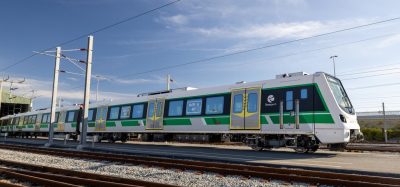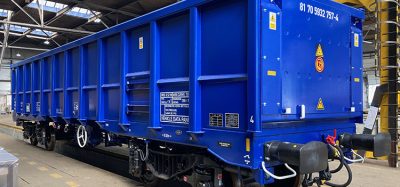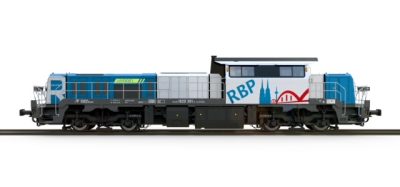Talgo 250: a fine example of train development
Posted: 30 July 2007 | | No comments yet
Talgo’s main objective since the establishment of the company in 1942, has been the constant research and development of innovative, simple and efficient solutions for railway operators – not only in the field of rolling stock, but also in providing integrated maintenance services customised according to the operator’s needs.
Talgo’s main objective since the establishment of the company in 1942, has been the constant research and development of innovative, simple and efficient solutions for railway operators – not only in the field of rolling stock, but also in providing integrated maintenance services customised according to the operator’s needs.
Talgo’s main objective since the establishment of the company in 1942, has been the constant research and development of innovative, simple and efficient solutions for railway operators – not only in the field of rolling stock, but also in providing integrated maintenance services customised according to the operator’s needs.
Talgo was the first private company in the world to provide integrated maintenance services to railway operators worldwide with a clear objective: to provide an outstanding service to our customers and passengers through a continuous knowledge of their needs, giving priority to preventive and predictive measures with one clear aim: ‘zero’ failures.
Today, Talgo is increasing its range of products that range from passenger tilting trains for commuter, regional and intercity traffic to very high-speed trains and electric locomotives without leaving behind the maintenance equipment such as under-floor wheel lathes, laser measuring equipments, shunting devices and other maintenance tools such as calibres.
The Talgo 250: an overview
The Talgo 250 was originally developed to meet Renfe’s needs to operate the latest generation of high-speed trains in an indistinctive manner within the Spanish rail network. It is important to bear in mind that Spain’s traditional gauge is 1,668mm with the electric supply in 3000 v D.C while the existing high-speed lines have been designed and built in the 1,435mm standard gauge and 25 kV. AC current. Thus, we can say that Spain is one of those unique countries with two different systems in terms of gauge, electric supply and signalling within the same network and Talgo has been able to provide a solution to this ‘uniqueness’. The Talgo 250 meets all these requirements: dual voltage (AC-DC), multiple signalling systems and variable gauge system ‘Talgo RD’ to be able to run on both gauges with a total adaptability.
Renfe’s version of the Talgo 250, named as S-130, is composed on two power heads and eleven intermediate coaches with a total length of 185 meters. The total passenger capacity of this version is of 299 passengers although, due to the high flexibility of this train, this capacity can be increased or reduced according the needs of other operators. The power heads incorporate Bombardier traction equipments and the intermediate coaches use Talgo’s main technological principles of aluminium welded body shells, articulated union between cars, independent wheels, permanently guided axles and natural tilting system. The Talgo 250 has been designed to run at speeds of 250km/h on the 1,435mm high-speed lines on AC current and 220km/h on the 1,668mm conventional network on DC current.
The power heads
Each power head is equipped with a dual voltage 25 kV 50 Hz AC and 3 kV DC traction system, with an installed power of 2.400 kW at 25 kV 50 Hz, one power group per bogie and one traction motor per axle which in a complete train set makes up a total of 8 tractor axles, 45% of the total number of axles in the trains. Each power head has one pantograph for 25 kV 50 Hz (AC) and another one for 3 kV (DC). Maximum weight per axle is 18t.
In terms of signalling, nothing has been left behind; since the Talgo 250 incorporates the ERTMS level 1 and 2 signalling systems with STM for LZB and ATP EBICAB 900 TBS as well as the dual ASFA signalling system used in the 1,668mm conventional network. GSM-R and Renfe’s Train-Ground communication systems are also installed in this high speed EMU.
The cabin is also an important part of the power head with a centred driving position for the driver, an ergonomic desk and seat with various possibilities of adjustments. The cabin is also pressurised, air tight and air conditioned to create an ideal working condition for the train driver.
The passenger coaches
The Talgo – design
The intermediate coaches of the Talgo 250 belong to the (7th) generation series of TALGO PENDULAR coaches designed for 250km/h.
As in previous Talgo projects, priority has been given in the design and construction of the coaches in terms of passenger safety and comfort and simplicity in the design, in order to achieve maximum reliability while keeping manufacturing, operating and maintenance costs low.
The coaches incorporate the basic technical principles of TALGO which are ideally suited for high-speed equipment and for achieving the maximum safety and comfort standards for passengers.
Articulated connection between cars
The Talgo 250 consists of two power heads and a series of intermediate coupled together in articulated fashion.
The bogies are shared between the cars, on the same transverse plane as the coupling point. The total number of Talgo trailer bogies is always equal to the number of passenger cars plus one.
The trainset thus forms an integral assembly providing greater running stability and greater safety, preventing the possible detachment of cars in the event of derailing.
This bogie arrangement means that the trainset has a very low number of axles (approximately half as many as an equivalent conventional trainset). This contributes to a perceptible reduction in wheel-rail forces, noise level generated and maintenance costs.
This configuration makes it possible to incorporate unique technical solutions to improve safety conditions (against overturning or telescoping) and running conditions. It also makes it possible to reduce the height of the trainset.
3 point stability
Each car body will be associated with a Talgo bogie upon which one of its ends is supported by means of two large-section pneumatic suspension springs.
The opposite end of the car body will be suspended from the adjacent car by means of a set of articulated shafts (weight bearers) designed to act as a point support. The car body will thus be supported at three points, its support base being triangular. This provides it with great stability and prevents the possible unloading of the wheels.
Lightweight construction
In order to reduce wheel-rail forces and energy costs in commercial operation, TALGO passenger cars are of lightweight construction with a low weight per seat. The passenger car bodies are constructed using large extruded aluminium alloy plates, welded together to constitute a self-bearing structure, and applying state-of-the-art design and manufacturing techniques.
Single-axle trailer trucks
Trailer bogies, mounted between adjacent car bodies, are single-axle type with their wheels on independent mountings. In this way it is possible to have sufficient space between the two wheels for passage between the cars, maintaining the low height of the trainset.
Trailer bogies with independent wheels offer significant advantages over axles using conventional techniques. This solution prevents the hunting of the truck and allows an excellent stability. The need for the two wheels on the same axle of being of identical diameter is also eliminated, offering important technical and economic advantages.
Guided trailer bogies
All trailer bogies in the train are always at angle zero and permanently guided on the track by means of simple and robust passive mechanisms. The guidance mechanism has the purpose of guiding the axles to maintain the wheels always parallel, both on straight and on curve track.
It also avoids the longitudinal displacements of the rolling assembly with respect to the car bodies.
Each axle has its own guidance mechanism constituted by the equaliser beam (1) and the guidance bars. One of the ends of the lower steering bars 2-2’ and the upper ones 3-3’ is joined to the supports 4-4’ 5-5’ of the bodyshells by an elastic hinge and the other one is joined to the equaliser beam by an elastic box hinge.
When the two-coupled cars have the same length both arms of the equaliser beam are equal and therefore, in a curve, its axle is oriented in the radial position regarding the centre of the curve. If the coaches have different lengths then it is necessary to have one of the arms longer than the other to orient the axles in the radial position. When the trainset is going into a curve the supports 4 and 5 situated in the bodyshells in the inboard side of the curve get closer and push the guidance bars 2 and 3, making the equaliser beam 1 turn around its axle, which produces the displacement of the axle of the wheel.
At the same time, in the outer side of the curve, the supports 4’ and 5’ move away and pull the steering bars 2’ and 3’ making the equaliser beam 1’ turn around its axle, producing a displacement in the axle of the wheel in the opposite direction but of the same distance. By doing this, as the orientation of the axle of the equaliser beams in direction to the centre of the curve is achieved, the wheels run parallel to the track. This mechanism is independent of the running direction.
Natural tilting of the car bodies
The Talgo 7th generation coaches are equipped with the Talgo natural tilting system. This system makes use of the lateral centrifugal force which naturally acts on the vehicles when they travel around a curve to tilt the cars towards the inside of the curve, thus considerably reducing the centrifugal force affecting the passengers.
The travelling speed of trains is often limited by the value of the lateral forces which passengers must withstand when travelling around curves. Therefore, the obvious result of the TALGO natural tilting system is to allow for an increase in the travelling speed on curved track and, by extension, on large sections of winding track, without reducing the level of passenger comfort.
This effect is achieved in Talgo Pendular trainsets simply by situating the plane of the main suspension spring assembly well above the car’s centre of gravity.
The resulting configuration is similar to that of a pendulum which naturally tilts when centrifugal forces act on it as it passes around a curve. The system has no actuator to tilt the car body and, as it depends exclusively on natural forces, is completely reliable.
Technical description of the passenger cars
The general features include:
- Gauge: The gauge is 1,435mm and 1,668mm along straight stretches, and the widening on curves will be as established by the UIC
- Maximum speed: The maximum circulation speed of these cars is 250Km/h., with fully acceptable stability, on tracks with a quality suitable for this speed
- Kinematic envelope: The cars are suitable for circulating on international gauge tracks falling within the UIC kinematic envelope as per leaflet 505.1
- Tilting: The intermediate cars are able to circulate at manoeuvring speed around curves of radius up to 100m. even when the kinematic envelop is not respected
The cars are able to circulate at route speed around curves of radius 250m., falling within the corresponding clearance in accordance with that stated above.
The cars are suitable for circulating stable along straight tracks at 250Km/h., and on curves at the speeds corresponding to a non-compensated centrifugal acceleration in the plane of the track of 1.5 m/s2.
Under these conditions, the transverse rolling stress on the rail does not exceed the value of 0.85.(1 + P/3), measured by the method of mean value over 2 m., at all times provided that the geometrical parameters of the track fall within the limit values set down in the existing RENFE standards or those of other Administrations of the UIC for circulating at those speeds.
The tilting of the cars, which will be originated in a natural manner, will take place for speeds above 70km/h. and radii of curvature less than 1,500m., at all times provided that there is centrifugal acceleration in the plane of the track. If there is no centrifugal acceleration or when the speed is less than the value stated or the radius of curvature is greater, then the pneumatic suspension system will keep the car body appreciably parallel to the plane of the track.
In short, the main characteristics of the VII Generation passenger cars of the Talgo 250 are:
- Hauled (non-powered) axles equipped with independent wheels to prevent hunting movement and to reduce wheel-track interaction
- Permanently steered axles by means of robust guiding bars that keep the wheels parallel to the track at all times
- High-comfort tilting suspension, with natural carbody tilting toward the interior of curves
- Articulated couplings between adjacent cars with anti-overturning and anti-vertical hunting mechanisms
From the operator’s point of view, the main advantages are:
- LIGHTWEIGHT-CONSTRUCTION CARS with a very low weight per seat, which results in a lower rate of energy consumption for commercial operation
- MINIMAL AGGRESSIVENESS AND WEAR on the tracks, thanks to the steered axles and with independent wheels
- ZERO-ENERGY CONSUMPTION to tilt the carbodies when traveling on curves
From the versatility point of view, the main advantages are:
- MAXIMUM COMMERCIAL SPEED: 250 km/h.
- Different possible CONFIGURATIONS which provides a high FLEXIBILITY
- Multiple operation capability with two coupled trains
- As an option, all the axles of the train, including those in the powered power heads, as it is the case of the Talgo 250, can be equipped with the variable-gauge Talgo RD system which allows the train to travel on tracks of different gauge without interruption.
The main technical features of the passenger cars are:
- Lightweight, short carbodies (13.14 m long), based on welded aluminum-alloy extrusions
- Mechanical resistance in accordance with UIC and FRA standards
- 2,942mm wide
- Anti-overturn and anti-override systems
- Five panoramic windows on each side wall
- Air-conditioning units underneath the frame
- Easy access, without steps, from the side of the car
- Automatic interior and exterior doors
- Ergonomic, reclining and rotating seats, adjustable to the direction of travel, with footrests
- Individual reading light and power outlet in every seat
- Personalized audio equipment with volume control and channel selector (four audio channels and two video channels)
- Video/TV screens
- One restroom in every car, with ecological toilets and vacuum empty cleaning
- Global Positioning System (GPS) equipment to inform passengers about the location of the train throughout the trip
- Liquid crystal displays with interactive information for passengers
- Cars with special features for wheelchair-bound passengers
- Bistro cars fully equipped to provide service
Conclusion
Thanks to the development of this train, Talgo has been able to completely cover the high speed needs that range from 220-250km/h with the Talgo 250 to 350km/h with the Talgo 350.
With an installed power of 4.800 kW and a total weight of 315 tons per train, the Talgo 250 has one of the lowest weight/power ratio in the world as well as being one the most environmentally friendly trains available in the market. This highly versatile and flexible train will begin commercial operation in Spain within the next months once the homologation process, currently under process, finalises. Current orders for the Talgo 250 add up to 45 trains-sets. The first four Talgo 250 trains have been delivered already and the delivery for the remaining 41 Talgo 250 trains will follow though out this year, 2008 and 2009. Once these trains enter into operation in Spain, Renfe will be able to provide a high quality service in intercity connections through out the complete network in Spain by using the 1435mm high speed lines and the 1668mm conventional lines indistinctively. Passengers in Spain will be the main beneficiaries of the Talgo 250 trains: journey times will be considerably reduced, new intercity connections will be offered, a high level of comfort and safety will be achieved, new on-board services will be provided and the existing infrastructure will be fully optimised.






